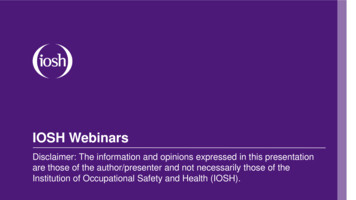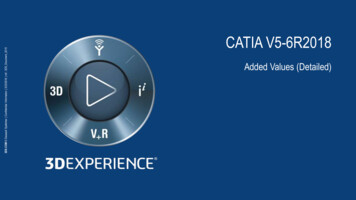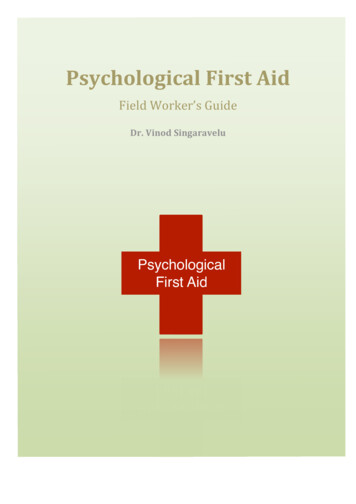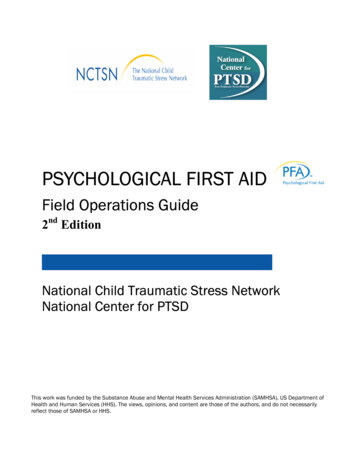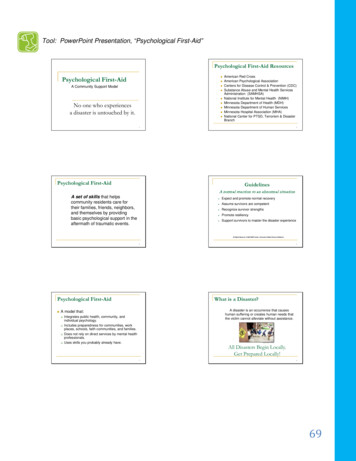
Transcription
Tool: PowerPoint Presentation, “Psychological First-Aid”Psychological First-Aid ResourcesPsychological First-Aid A Community Support Model No one who experiencesa disaster is untouched by it. American Red CrossAmerican Psychological AssociationCenters for Disease Control & Prevention (CDC)Substance Abuse and Mental Health ServicesAdministration (SAMHSA)National Institute for Mental Health (NIMH)Minnesota Department of Health (MDH)Minnesota Department of Human ServicesMinnesota Hospital Association (MHA)National Center for PTSD, Terrorism & DisasterBranch14Psychological First-AidGuidelinesA normal reaction to an abnormal situationA set of skills that helpscommunity residents care fortheir families, friends, neighbors,and themselves by providingbasic psychological support in theaftermath of traumatic events. Expect and promote normal recovery Assume survivors are competent Recognize survivor strengths Promote resiliency Support survivors to master the disaster experienceAll Rights Reserved 2005 DEEP Center / University of Miami School of Medicine2Psychological First-Aid What is a Disaster?A disaster is an occurrence that causeshuman suffering or creates human needs thatthe victim cannot alleviate without assistance.A model that: 5Integrates public health, community, andindividual psychology.Includes preparedness for communities, workplaces, schools, faith communities, and families.Does not rely on direct services by mental healthprofessionals.Uses skills you probably already have.All Disasters Begin Locally.Get Prepared Locally!3669
What is a Critical Incident?SAFETY, FUNCTION, ACTION:Psychological First Aid for Disaster SurvivorsOUTCOMESA natural or man-made event orsituation that has the potential totemporarily overwhelm the abilityto maintain ingphysical safetyand diminishingthe calfunctionand perceivedsense of safetyand control.Initiatingaction towarddisasterrecoveryand return tonormal activity.710 ACTION:Source: Shultz, Cohen, Watson, Flynn, Espinel, Smith. SAFETY, FUNCTION,Psychological First Aid for Disaster Survivors. Miami FL: DEEP Center 2006.SAFETY, FUNCTION, ACTION:Psychological First Aid for Disaster SurvivorsSAFETYWhat Survivors Need:SAFETYSAFEGUARDSafetySecurityShelterWhat To Do:Remove from harm’s way.Remove from the scene.Provide safety and security.Provide shelter.Reduce stressors.8Psychological First-Aid11 ACTION:Source: Shultz, Cohen, Watson, Flynn, Espinel, Smith. SAFETY, FUNCTION,Psychological First Aid for Disaster Survivors. Miami FL: DEEP Center 2006.SAFETY, FUNCTION, ACTION:Psychological First Aid for Disaster SurvivorsSAFETYSAFETYThe ModelSkillsWhat To Do:SUSTAIN970What Survivors Need:Basic survival needsProvide food, water, ice.Provide medical care, alleviate pain.Provide clothing.Provide power, light, heat, air conditioning.Provide sanitation.12 ACTION:Source: Shultz, Cohen, Watson, Flynn, Espinel, Smith. SAFETY, FUNCTION,Psychological First Aid for Disaster Survivors. Miami FL: DEEP Center 2006.
SAFETY, FUNCTION, ACTION:SAFETY, FUNCTION, ACTION:Psychological First Aid for Disaster SurvivorsPsychological First Aid for Disaster SurvivorsFUNCTIONFUNCTIONACTIONWhat Survivors Need:ACTIONSoothing human contactValidation that reactions are “normal”.COMFORTWhat To Do:Establish a compassionate “presence.”Listen actively.Comfort, console, soothe, and reassure.Apply stress management techniques.Reassure survivors that their reactions are“normal” and expectedWhat To Do:EMPOWER13 ACTION:Source: Shultz, Cohen, Watson, Flynn, Espinel, Smith. SAFETY, FUNCTION,Psychological First Aid for Disaster Survivors. Miami FL: DEEP Center 2006.Psychological First Aid for Disaster SurvivorsFUNCTION16 ACTION:Source: Shultz, Cohen, Watson, Flynn, Espinel, Smith. SAFETY, FUNCTION,Psychological First Aid for Disaster Survivors. Miami FL: DEEP Center 2006. What Survivors Need: Social supports/keeping family togetherReuniting separated loved onesConnection to disaster recovery services,medical care, work, school, vital services What To Do:CONNECTSet realistic disaster recovery goals.Problem solve to meet goals.Define simple, concrete tasks.Identify steps for resuming normal activities.Engage able survivors in helping tasks.General GuidelinesSAFETY, FUNCTION, ACTION:FUNCTIONWhat Survivors Need:Planning for recoveryPractical first steps and “do-able” tasksSupport to resume normal activitiesOpportunities to help othersKeep survivor families intact.Reunite separated loved ones.Reunite parents with children.Connect survivors to available supports.Connect to disaster relief services, medical care. Tell the truth as it is known,when it is known.Explain what is being done todeal with the problem.Avoid withholding bad news ordisturbing information.Be forthright about what is notknown.Provide practical guidance forcitizen protection.Sources: Glass et al. 2002;Pilch,17 200414SAFETY, FUNCTION, ACTION:Psychological First Aid for Disaster SurvivorsACTIONACTIONEDUCATEWhat Survivors Need:Information about the disasterInformation about what to doInformation about resourcesReduction of uncertaintyWhat To Do:Clarify disaster information: what happened what will happenProvide guidance about what to do.Identify available resources.15 ACTION:Source: Shultz, Cohen, Watson, Flynn, Espinel, Smith. SAFETY, FUNCTION,Psychological First Aid for Disaster Survivors. Miami FL: DEEP Center 2006.SAFETY, FUNCTION, ACTION:Psychological First Aid for Disaster TEGoal: SAFEGUARDsurvivors fromharm andoffer protection.Goal: COMFORTsupport, validate,and orientdistressed survivors.Goal: EDUCATE and informsurvivors about the disaster,available options for action,and resources for support.SUSTAINCONNECTEMPOWERGoal: SUSTAINsurvivorsby providingbasic needs.Goal: CONNECTsurvivors tofamily, friends, andsocial supports,Goal: EMPOWER survivorsto take first steps towarddisaster recovery and fosterself-efficacy and resilience.18 ACTION:Source: Shultz, Cohen, Watson, Flynn, Espinel, Smith. SAFETY, FUNCTION,Psychological First Aid for Disaster Survivors. Miami FL: DEEP Center 2006.71
SKILLS: StressThe Stress ResponseStress is: Normal Productive or destructive Acute or chronic Cumulative over time Preventable Manageable Physical – Body Reactions Emotional – Feelings Cognitive – Thinking and decision making Behavioral – Actions Spiritual – Beliefs and values1922Common Physical Reactions toTraumatic Stress in AdultsLife isinherentlystressful Elevated heart rateElevated blood pressureElevated blood sugarStomach upset, nauseaGastrointestinal problems (diarrhea, cramps)Sleep difficultiesWith extended stress, suppression of immunesystem functioning20StressorsCommon Physical Reactions toTraumatic Stress in ChildrenEvents or situations that produce physicalor psychological reactionsStressors can be:Real or imaginedInternal or externalAbsolute or perceived217223 Headaches Stomachaches Nausea Eating problems Other physical reactions24
Common Emotional Reactions toTraumatic Stress in Adults Fear and anxiety Sadness and depression Anger and irritability Feeling numb, withdrawn, or disconnected Feeling a lack of involvement or enjoyment infavorite activities Feeling a sense of emptiness or hopelessnessabout the futureCommon Cognitive Reactions toTraumatic Stress in Children Confusion and disorientation Particularly difficult symptom for school-age childrenDifficulty concentrating May appear as behavioral problems in classroom*Note that school may be place where childfunctions best: Continuing structure, predictability Child may retain a sense of control25Common Emotional Reactions toTraumatic Stress in Children Common Behavioral Reactions toTraumatic Stress in AdultsAnxiety, fear, vulnerabilityFear of reoccurrenceFear of being left alone 28Especially if separated from family during eventMay seem like an exaggerated reaction to adultsLoss of “Sense of Safety”DepressionAngerGuilt Family challenges (physical, emotional abuse) Substance abuse Being overprotective of family Keeping excessively busy Isolating self from others Being very alert at times, startling easily Problems getting to sleep or staying asleep Avoiding places, activities, or people that bringback memories26Common Cognitive Reactions toTraumatic Stress in Adults29Common Behavioral Reactions toTraumatic Stress in Children “Childish” or regressive behavior Difficulty concentrating Difficulty with memory Intrusive memories Recurring dreams or nightmares Sleep onset insomnia Flashbacks Midnight awakening Difficulty communicating Fear of dark Difficulty following complicated instructions Fear of event reoccurrence during night 27May not be deliberate acting outBedtime problems3073
Common Reactions to Traumatic Stress –Faith & Spirituality in Adults & Children SKILLS: Active Listening Reliance upon faithQuestioning values and beliefsLoss of meaningDirecting anger toward GodCynicismEye contactFacial expressionTone of voiceHead movement31Event is more traumatic when 34Active Listening Event is unexpectedMany people die, especially childrenEvent lasts a long timeThe cause is unknownEvent is poignant or meaningfulEvent impacts a large area Verbal Support Tone of voice Not too loud Encouraging prompts/head movement Support personal pacingPhysical Contact Pat on back Hug Follow lead of person32Factors that make traumatic eventsless stressful 35Active Understanding PreparationTrainingTeamwork, cooperation, camaraderie 3374Try not to interruptAsk questions to clarifyOccasionally restate a part of the story in your ownwords to make sure you understandEstablish sequenceAvoid “Why?” and “Why not?”Avoid “I know how you feel”Avoid evaluation of their experience and theirreactions in the eventSilence is OK36
AgitationBasic Principle of Helping: Some may become agitated Refusal to follow directions Loss of controlWHEN IN DOUBT Become threatening This is a reaction to anUNCOMMON situation, andhas nothing to do with youREFER TO APROFESSIONAL! Seek help from security3740Basic principles Specific reactions that MAY indicateadditional needsPrivacyRespectNon-judgingImpartialEqual care for all Gender, age,ethnicity, religion, politicalperspective, and culture Difficultly thinking clearly or acting logicallyBizarre behaviorLacking awareness of realityExtreme stress reactions or griefConfusionInability to concentrate or make decisionsHaunted by images or memories of the eventComplaining of physical symptoms afterreassurance that there are none38Your Role41Referrals for Additional Care and Support(IMMEDIATE) A CompassionatePresence 39DisorientationPsychotic behaviorInability to care for selfSuicidal/homicidal thoughts, talk, or plansInappropriate anger or reactions to triggersExcessively “flat” emotionsRegressionProblematic alcohol or drug useFlashbacks, excessive nightmares, or crying4275
Personal Resiliency PlanSelf-Care: Are You Ready Really?Focus beyond short-termKnow your unique stressors andRed FlagsKnow unique stressors of theevent: extent of damage, death,current sufferingDemystify/de-stigmatize commonreactionsSelect from menu of copingresponsesMonitor on-going internal stress Evaluate your level of readiness to respond Do not assume that because you areexperienced you must be ready to respond Give consideration to your physical andemotional health If you have recently encountered a major lifestressor it may be better for you and those whoneed assistance for you to NOT to respond 4346Building Responder ResiliencePre-eventWhat is Resilience? Positive adaptation inthe face of adversity Educate and train Ordinary--notextraordinary Build social support systems People commonlydemonstrate resilience Instill sense of mission and purpose The “rule” not theexception Create family communications plan44ResponsePromote Resiliency Everyone who experiences a disaster is touchedby it If possible deploy as a team or use the buddysystem We have the ability to “bounce back” after adisaster to a “New Normal” Focus on immediate tasks at hand Monitor occupational safety, personal health,and psychological well-being Know your limits Activate family communication plans Resilience can be fostered One goal of Psychological First-Aid: supportresiliency in ourselves and others45764748
Post-event (Recovery)Self Care After Support WorkMonitor health and well-being Delayed reactions with increased demand for servicesseen in general public and emergency responders(onset 5 wks later) Give yourself time to recover Seek support when needed49 Expect a reintegration period uponreturning to your usual routine Pay attention to cues from your familythat you are becoming too involved5077
Activity: Self-Assessment Questionnaire of ReadinessEvaluate your capabilities, limitations, and needs to be able to respond to an emergency while at work.Abilities/ PreparednessYes No Do you know the location of all fire alarms and extinguishers?Yes No- Are you able to activate the fire alarms?Yes No Can you operate a fire extinguisher?Yes No- Have you practiced?Yes No Do you know the location of ALL exits?Yes No- Have you evaluated your ability to use them?Yes No Have you determined how you may be of assistance to others in an emergency? (i.e. guidingpeople through darkened spaces and exits if you have no or low vision, offering emotional orcalming support)Yes No Do you keep critical carry-with-you supplies? (Medication, small flashlight, fully chargedportable devices, paper/pen/pencil, emergency health information)EvacuationYes No Would you be able to evacuate after normal business hours?Yes No- Do you know how to reach emergency personnel and facility response staff in case of anemergency after normal business hours?Yes No Do you know where the facility’s designated meeting place is located?Yes No- Have you practiced?Yes No Do you know how you would be signaled/told to evacuate the building?Yes No- Have you practiced?Yes No Have you determined how you may be of assistance to others during an evacuation? (i.e.guiding people through darkened spaces and exits if you have no or low vision, offeringemotional or calming support)Personal PreparednessYes No If you wear contact lenses, what will you do if and when smoke, dust, or fumes become painfulor dangerous. Do you keep glasses with you?Yes No Do you know the location of telephones throughout the facility?Yes No Do emergency alarm systems have audible and visible features?Yes No If you are hard of hearing, will you be able to hear over the sound of very loud emergencyalarms? How will you understand emergency information and directions that are usually givenverbally? Tell your support network how to help you.Yes No Do you have a personal support network? (Those that will help you if you are sick or unable torespond in an emergency.)Yes No Have you anticipated the types of reactions you may have in an emergency situation andplanned for coping with them? (Ex. stress, confusion, fear)Yes No Do you know how to assist with a wheelchair? What will it take to evacuate a person in awheelchair from the building?Yes No Have you labeled essential equipment or documents that you may need and kept them in aplace where they can be removed from the facility during an evacuation? Are these documentsbacked-up at any other location?Yes No Do you carry supplies with you based on your worst days? (asthma inhalers, gloves, nicotinegum, etc)Yes No Does your emergency health information card clearly explain your sensitivities and reactions,helpful treatments, doctors’ information, insurance information, etc?Yes No Do you have emergency basic supplies with you at work in case you have to ‘shelter in place’?(food, water, clothes, etc)Yes No Do you have a family emergency communication plan so that you can be assured of yourfamily’s safety during an emergency?78
Activity: Individual Continuity PlanningPlanning to continue operations during an emergency helps to identify your critical job functionsand how you plan on carrying them out under unusual circumstances. You should think aboutwhat your specific job functions are, how they are done normally, how they could be performedoutside of the norm, and how you would communicate with your organization.Your personal planning (done on this worksheet) will be a complement to your faithorganization’s continuity of operations plan. Making a plan for yourself will help you and yourorganization react to an emergency in a timely manner. Remember, this document may covermore than you need to plan for, or it may not have all that you need to plan. This is just a‘jumping off point’ for planning. You can make your plans anything you want as long as theywork for you and your organization.Job FunctionWhat are your overall jobfunctions?CommentsWhat are your most criticaljob functions? (What do youhave to do to keep theorganization running?)Prioritize these critical jobfunctions:Modify your list if necessaryto take seasonalcircumstances into account.What do you absolutelyneed/require to do your job?DependenciesWhat other jobs or jobfunctions do you absolutelyneed to do your job?Are there alternatives tothese needs/functions?Do you rely on anotherperson (either internally orexternally) to do your job?Do they have a plan?79
Do others rely on you to dotheir jobs? Are you makingthese functions a priority foryou? (Work with these otherpeople to help create alarger plan.)AlternativesCan you do your job from adifferent location? (Ex.home, a different office, adifferent faith organization)How would you do your jobfrom a different location? Doyou have the equipment athome that is necessary?Can you do your job withoutelectricity? How?Are your alternativesrealistic? If not, can youmake them more feasible?Is there a time limit for beingable to perform your jobunder different conditions?CommunicationWhat communicationmethods do you useexternally and internallynow?Will you be able to maintainthese lines ofcommunication in anemergency?Prioritize yourcommunication methods:Will you be able to maintaincommunication if lines arelimited (no phone, noelectricity)? How?80
Organization LevelDo your answers (your plan)align with yourorganization’s priorities,mission, people, property?Do your answers (your plan)align with yourorganization’s Continuity ofOperations Plan?Who will be receiving thisplan? (Everyone shouldknow what the plans are.)In the event of anemergency, could you takeon another role with yourorganization?What other role?Can someone take on yourjob functions (if you areunable to perform it)? Whocould? (Talk with them andwork together on this plan.)You should review andupdate your plan annually –make a date now.Additional Notes:81
Activity: Get a Kit TogetherThe following list will help you determine what to include in your disaster supplies kit that willmeet your family’s needs. This list may have a LOT more than you need or it may not haveenough. Every individual and family is different and will have different needs during anemergency. Create your kits to fit your own needs.There are two ways you can go about creating a kit: (1) purchase “one extra” and (2)stockpiling. Purchasing “one extra” means that a person has not created a separate stockpile ofemergency supplies, but rather, essential items are purchased and rotated in a quantity thatallows a family to survive for five days at home. These supplies are usually kept as part of thefood and daily use items in the home. The stockpile philosophy means that a person buyssupplies which are usually kept in the basement or other storage area and are not used untilthere is an emergency.Do not forget family members with special needs who may require extra items to survive (i.e.hearing aid batteries, prescription medications, diapers, baby formula, etc) and your pets.Remember to rotate your supplies occasionally so they do not expire. There are some largebarriers to people and families making these kits. If you can, donate your time and resources toassist others once you have begun.One great way to motivate your entire congregation to stock up is to put one item on displayevery week for everyone to purchase. For example, the first week you could display a manualcan opener and encourage everyone to make that purchase over the week. During the nextweek, display a gallon of water and so on. You may want to see if a store close by will partnerwith you to offer your display items on sale the week everyone should buy it.First Aid SuppliesSuppliesAdhesive bandages, various sizes5" x 9" sterile dressingConforming roller gauze bandageTriangular bandages3" x 3" & 4" x 4" sterile gauze padsGermicidal hand wipes or waterless, alcohol-based handsanitizerAntiseptic wipesLarge, medical grade, non-latex glovesTongue depressor bladesAdhesive tape, 2" widthAntibacterial ointmentCold packScissors (small, personal)82Home Vehicle Work
TweezersAssorted sizes of safety pinsCotton ballsThermometerTube of petroleum jelly or other lubricantSunscreenCPR breathing barrier, such as a face shieldFirst-aid manualNon-Prescription and Prescription Medicine Kit SuppliesSuppliesHome Vehicle WorkAspirin and non-aspirin pain relieverAnti-diarrhea medicationAntacid (for stomach upset)LaxativeVitaminsPrescriptionsExtra eyeglasses/contact lensesSanitation and Hygiene SuppliesItemItemWashcloth and towelHeavy-duty plastic garbage bags andties for personal sanitation uses andtoilet paperTowelettes, soap, hand sanitizerMedium-sized plastic bucket with tightlidToothpaste, toothbrushesDisinfectant and household chlorinebleachShampoo, comb, and brushSmall shovel for digging a latrineDeodorants, sunscreenToilet paperRazor, shaving creamContact lens solutionsLip balm, insect repellentMirrorFeminine supplies83
Equipment and ToolsToolsKitchen itemsPortable, battery-powered radio or TVManual can openerNOAA Weather Radio, if appropriate foryour areaMess kits or paper cups,plates and plastic utensilsFlashlight and extra batteriesAll-purpose knifeSignal flareHousehold liquid bleach totreat drinking waterMatches in a waterproof container (orwaterproof matches)Sugar, salt, pepperShut-off wrench, pliers, shovel, and othertoolsAluminum foil and plasticwrapDuct tape and scissorsResealable plastic bagsPlastic sheetingSmall cooking stove and acan of cooking fuel (if foodmust be cooked)WhistleBatteriesComfort ItemsSmall canister, ABC-type fire extinguisherTube tentGamesCompassCardsWork glovesBooksPaper, pens and pencilsToys for kidsNeedles and threadFoodsBattery-operated travel alarm clockFood and WaterSuppliesWaterReady-to-eat meats, fruits and vegetablesCanned or boxed juices, milk and soupHigh-energy foods such as peanut butter, jelly, lowsodium crackers, granola bars and trail mixSpecial foods for infants or persons on special dietsCookies, hard candyInstant coffeeCerealsPowdered milk84Home Vehicle Work
Clothes and Bedding SuppliesItemComplete change of clothesSturdy shoes or bootsRain gearHat and glovesExtra socksExtra underwearThermal underwearSunglassesBlankets/sleeping bags and pillowsDocuments and KeysItemStoredPersonal identificationCash and coinsCredit cardsExtra set of house keys and car keysPrayer book and/or other important faith-related itemsCopies of the following:Birth certificateMarriage certificateDriver's licenseSocial Security cardsPassportsWillsDeedsInventory of household goodsInsurance papersImmunization recordsBank and credit card account numbersStocks and bondsEmergency contact list and phone numbersMap of the area and phone numbers of places you could goSource: U.S. Department of Homeland Security Federal Emergency Management Agency (modified).85
86
Tool: PowerPoint Presentation, “Psychological First-Aid” Psychological First-Aid A Community Support Model No one who experiences a disaster is untouched by it. 1 Psychological First -Aid A set of skills that helps community residents care for their families, friends, neighbors, and t





